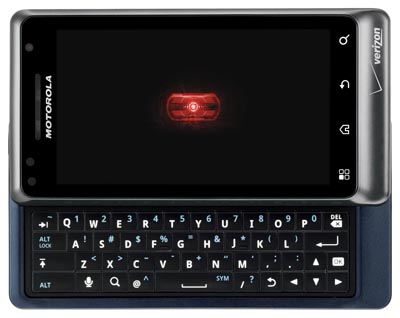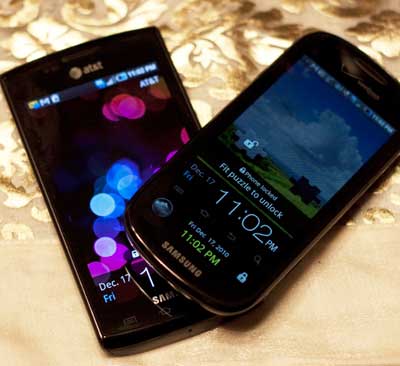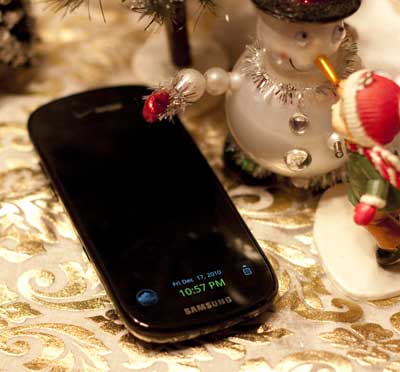Gifts of Christmas 2010: Android Phones
Cell phones are always amongst the items that show up on Christmas wish lists. But, amongst the vast array available, how can you pick the right one to give? Over the next few days, we will look at some of the most interesting phones of the year, starting with four current Android models today, highlighting just whom they will best serve.
Android has grown up a lot in the last year. When the Droid first appeared in October 2009 and put Android on the map, the platform still felt relatively immature, at least compared to the well-established iPhone line or the less successful, but attractive webOS of Palm’s offerings. A year later, Android phones are on every carrier of note and have matured quite a bit in design.
If the person you are shopping for has not already become loyal to a particular phone platform, there are three platforms worth your consideration, depending on the person’s need. For most intents and purposes, the cell phone market is presently a two horse race between Apple’s iOS and Google’s Android. That said, Microsoft is making an extremely credible attempt at reestablishing itself in the market with Windows Phone 7. We will look at iOS and Windows Phone in the next installment of this series.
For its part, Android is a fiercely competitive platform and offers quite a few innovative phones. Google Maps Navigation remains the gold standard of cell phone GPS solutions and, unlike the alternative GPS solutions, it is entirely free with any modern Android phone. This alone is a good reason for the uncommitted to consider Android as their phone platform. Moreover, Google’s unrestricted approach allows Android phones to be tweaked more than an iOS or Windows Phone device, making it a perfect choice for the person on your list who loves endlessly customizing things.
Droid 2 (Verizon)
Much of what we said earlier this year about the Droid X can also be said for this phone, which serves as the first true successor to the original Droid released last year by Motorola and Verizon. Like the Droid X, the Droid 2 features a 1 GHz processor and a high-resolution display. Nevertheless, the two devices are distinct: the Droid X has a mammoth 4.3” display whereas the Droid 2 has a smaller screen, but sports a physical keyboard.
That keyboard is a very justifiable point for the Droid 2 to stake out as its claim to fame, for it is quite simply excellent. As with the original Droid, the Droid 2 allows one to type quickly and comfortably, perhaps more so than with either a soft keyboard or vertical orientation mechanical keyboard (seen, for example, on Blackberry and Palm webOS lines). This is particularly true on Android, where soft keyboards have lagged somewhat behind iOS in accuracy.
Oddly, while the phone shares its internals with the Droid X, we found the Droid 2 seemed to lag at times compared to its bigger brother. In particular, scrolling at times was sometimes noticeably choppy. However, after we had begun testing, the Droid 2 was replaced with the slightly upgraded Droid 2 Global Edition, which in addition to support for GSM roaming abroad, also packs a slightly more powerful processor that may rectify this issue.
 |
|
The Droid 2 features a very comfortable, large keyboard. |
While the Droid X has a much larger, 4.3” display, the smaller display of the Droid 2 has just as high of resolution, resulting in a much denser display closer to that of the iPhone 4’s “Retina Display,” though not all the way there.
Like the Droid X, the Droid 2 ditches the disastrous Motoblur skin that Motorola tried offering on many of its phones. Yet Motorola wisely retained the best feature of that failed experiment, a unified inbox for Facebook, Twitter and e-mail. While we think HTC’s Sense UI-based phones have a superior take on Android, Motorola’s unified inbox is simply the best centralized inbox offered on a smartphone right now and makes Motorola’s devices especially good choices for those who do a lot of communication over a mixture of e-mail and social networking.
The phone’s calling quality was good. While falling short in clarity behind the iPhone and Galaxy S line from Samsung, we think it provides a more natural sound than the latter.
The camera on the Droid 2 is decent, producing good color and low noise when outdoors, producing generally pleasing shots both indoors and out. While we think the Samsung Fascinate (below) or the Droid X produces somewhat better shots, the Droid 2 held its own.
To whom you should give this phone: Avid texters, mobile e-mail writers and others who will likely make heavy use of a phone’s keyboard will benefit from the Droid 2’s superb, landscape slide out keyboard.
Other models you should consider: For the mobile video lover, especially someone who will be taking and viewing home movies on a mobile phone, the Droid X is a hands down better choice. For aesthetes, the HTC Droid Incredible offers similar hardware and a superior user experience for $50 less (Motorola/Verizon, $199, www.vzw.com).
Samsung Galaxy S Phones: Captivate and Fascinate (AT&T and Verizon)
Samsung made a big splash with its Android phones this year by launching numerous variants of its basic Galaxy S design, each customized for a different cellular operator. We were able to test three of these, including the Captivate for AT&T and the Fascinate for Verizon (the final, the Continuum, also on Verizon, is discussed below).
 |
|
The Captivate (left) and Continuum, two of Samsung's Galaxy S phones. |
The two phones are remarkably similar, each providing a sleek, well constructed take on the Android soft-keyboard phone. Both the Captivate and the Fascinate are light and sturdy, although the Captivate’s metal back gives it a slightly higher end, sturdier feel that we preferred over the Fascinate’s all plastic body. In both cases, Samsung continues its trend of producing some of the very finest crafted phones that have passed through the Labs.
The Samsung phones’ 4.0” displays are absolutely beautiful, with bright vibrant colors and excellent contrast. The AMOLED technology employed by the displays makes them especially nice when viewing photos or other multimedia. On the other hand, the nature of current AMOLED displays leads to text that is less readable than on LCD equivalents. Keeping this in mind, the readers on your gift list will likely be happier with LCD sporting phones, though the more multimedia inclined will likely love Samsung’s offering.
We found the Samsung phones produced clear, crisp call quality that was superior to other recent Android phones we have tested. Signal strength on both phones was good, and battery life is positively excellent.
Both the AT&T and Verizon versions feature Samsung’s TouchWiz UI. Many of Samsung’s tweaks on the interface appear essentially to be attempts to copy design cues from Apple’s iOS, and the choices mostly work, though we would like to see Samsung spend a little more time polishing up its design. As Android interfaces go, we prefer Motorola’s less modified Android user interface or HTC’s more polished and original UI. Because Samsung’s design is so similar to the iPhone’s, at points we found ourselves disappointed when the phones did not perform as intuitively as an iPhone.
A touch we do really appreciate in TouchWiz is actually in the oft overlooked, but frequently used phone calling interface. If one begins to enter a phone number, a browser-like auto correct feature offers possible phone number completions accompanied (when possible) with the contact’s photo.
One big difference should be noted with regards to the software on the Verizon and AT&T models. Curiously, unlike on its other Android phones, Verizon stripped their Samsung Android phones of Google functionality, replacing Google Search and Google Maps with clunky Bing alternatives (the switch of mapping applications is especially curious, since it eliminates the free Google Maps Navigation, though one can grab it off the Android Market). Samsung’s site talks of the Google experience on the Fascinate, including showing a Google search box, but sadly those features are absent from the actual phone. Happily, AT&T has left the Google software intact on its version.
 |
|
While the Continuum (left) and Fascinate (right) were able to cope with our macro “stress test,” the Captivate (middle) struggled in the indoor mid-to-low light situation, however this Photoshop lightened photo demonstrates that the phone's camera does capture a good level of detail even in very dark exposures. |
Both models include Samsung’s take on the mobile hotspot feature, allowing one to share the phone’s Internet connectivity with other devices. This is one place where Samsung has triumphed in user experience; its hotspot function is notably easier and more convenient to use than that on the Motorola Droid line or even the Palm webOS line.
The phones produce superb pictures using their respective 5 megapixel cameras. We found the Fascinate produced the best photos amongst the phones reviewed in this article, aided by a very good flash, something the Captivate surprisingly lacks. In our low, natural light macro “stress test,” the Captivate did not compensate well for its lack of flash by slowing the shutter; nevertheless, when we brightened the resulting image, it was actually a tad sharper than the Fascinate’s otherwise better exposed version. Outdoors, both phones produced excellent photos.
To whom you should give this phone: Anyone looking for a sleek Android-powered phone with a large display and a pleasing camera will appreciate these phones.
Other models you should consider: The iPhone 4 is the obvious choice for gift recipients who are AT&T users, since the TouchWiz UI essentially draws its cues from iOS, but comes up short. For Verizon users, the excellent HTC Droid Incredible should be seriously considered; despite being six months older than the Galaxy S line, the Incredible holds up well with its robust specifications and beats it in user interface design (Captivate from Samsung/AT&T, $199, wireless.att.com; Fascinate from Samsung/Verizon, $199, www.vzw.com).
Samsung Continuum (Verizon)
The Continuum, like its other Galaxy S siblings considered above, shares Samsung’s speedy 1 GHz processor and aforementioned TouchWiz user interface. The comments offered concerning the Fascinate, above, apply to this phone as well. However, what distinguishes the Continuum is its unique display situation – a smaller 3.4” main display paired with a “ticker” status display that can be activated by a touch sensitive area on the phone.
This arrangement makes the Continuum a unique cell phone experience – one with an enjoyably quirky personality – perfect for a news or social network junkie. The phone’s “ticker” display can monitor RSS feeds (either preset ones such as CNN and the New York Times or custom ones), Facebook, Twitter, e-mail and weather. Without even activating the main display, the phone will flash information on the smaller screen and, optionally, play an alert, whenever a feed it is monitoring receives an update.
If one wants to quickly check any of these items, one can simply touch the sides of the phone and the ticker will be displayed. Different feeds can be browsed simply by flicking through them. While the 3.4” main display feels somewhat cramped compared to the spacious Fascinate and Captivate displays, for at least some people, the tradeoff for the innovative ticker could very well prove worthwhile.
Thanks to the software that manages the phone’s ticker system, we also found that the Continuum featured tighter integration with social networks than its Galaxy S stablemates, providing a seamless handoff and configuration between the integrated Facebook functionality and the Facebook for Android application. On the other Galaxy S phones, some functions of the built-in Facebook contact sync overlap with the functionality provided by the actual Facebook application, which can lead to confusion.
 |
|
The Continuum with just its ticker display active, showing the time and weather conditions. |
The Continuum, like the Fascinate, features a camera with flash, though we found this model’s flash seemed to be more inclined to overexposing photos, which in turn threw off the autofocus in some pictures.
Though the dual screen approach may not be for everyone, the Continuum offers a surprisingly attractive, thoughtful feature set making it worth considering. Those who would prefer a phone that marches to its own drummer will definitely appreciate this unique device.
To whom you should give this phone: Avid news watchers, social networkers and others who love being connected constantly will be delighted by the Continuum’s ticker functionality.
Other models you should consider: The Continuum has no direct competition, although the other Galaxy S models and iPhone 4 remain good, less quirky options (Samsung/Verizon, $199, www.vzw.com).
One amazing thing we can note about the current crop of Android phones is that all of them are very good. While the different models, with their varying strengths, clearly will appeal more or less to different people on one’s shopping list, if you are looking to gift an Android phone this year, one of the phones above will certainly delight almost anyone.
Join the Conversation
Pingback: Twitter Trackbacks for The Gifts of Christmas: Android Phones - OFB.biz: Open for Business [ofb.biz] on Topsy.com
“wf-main”>